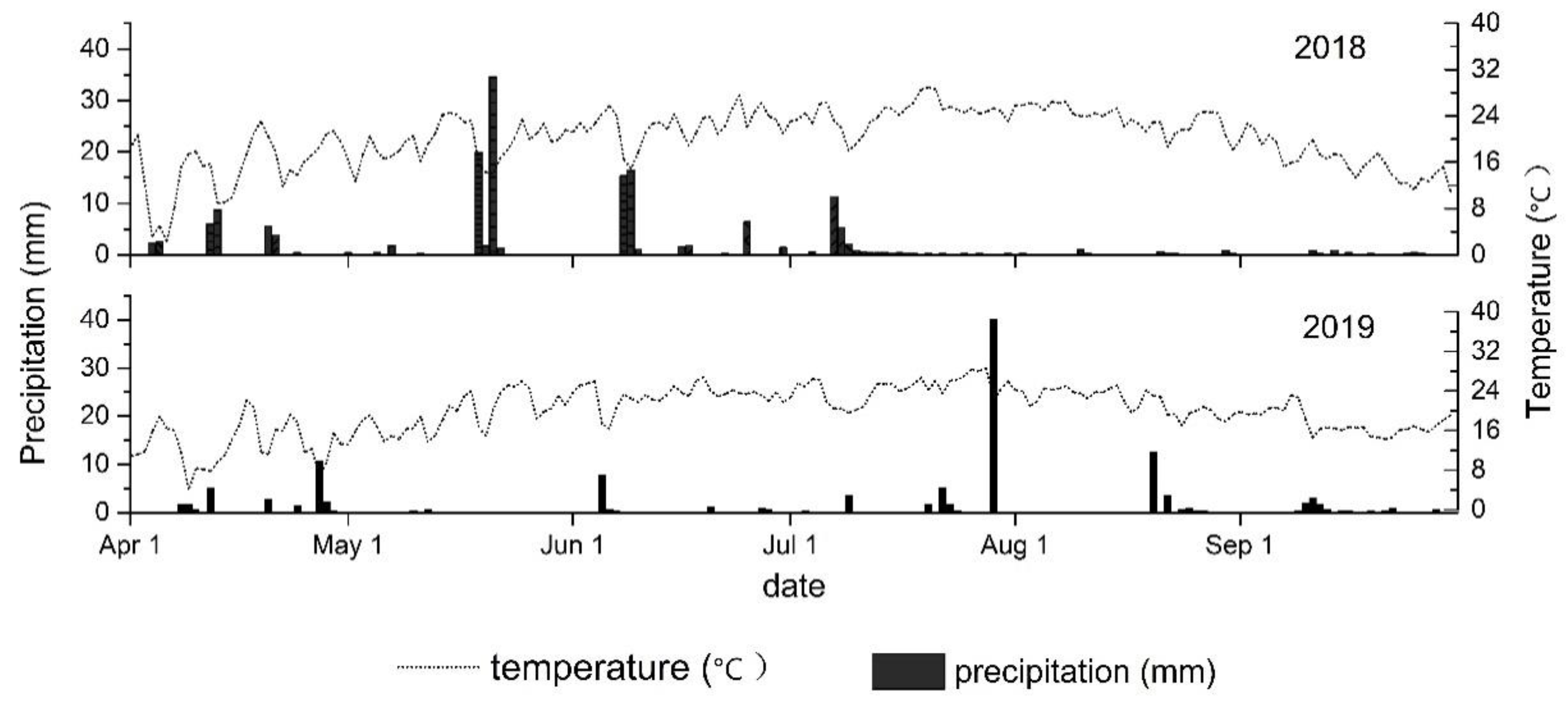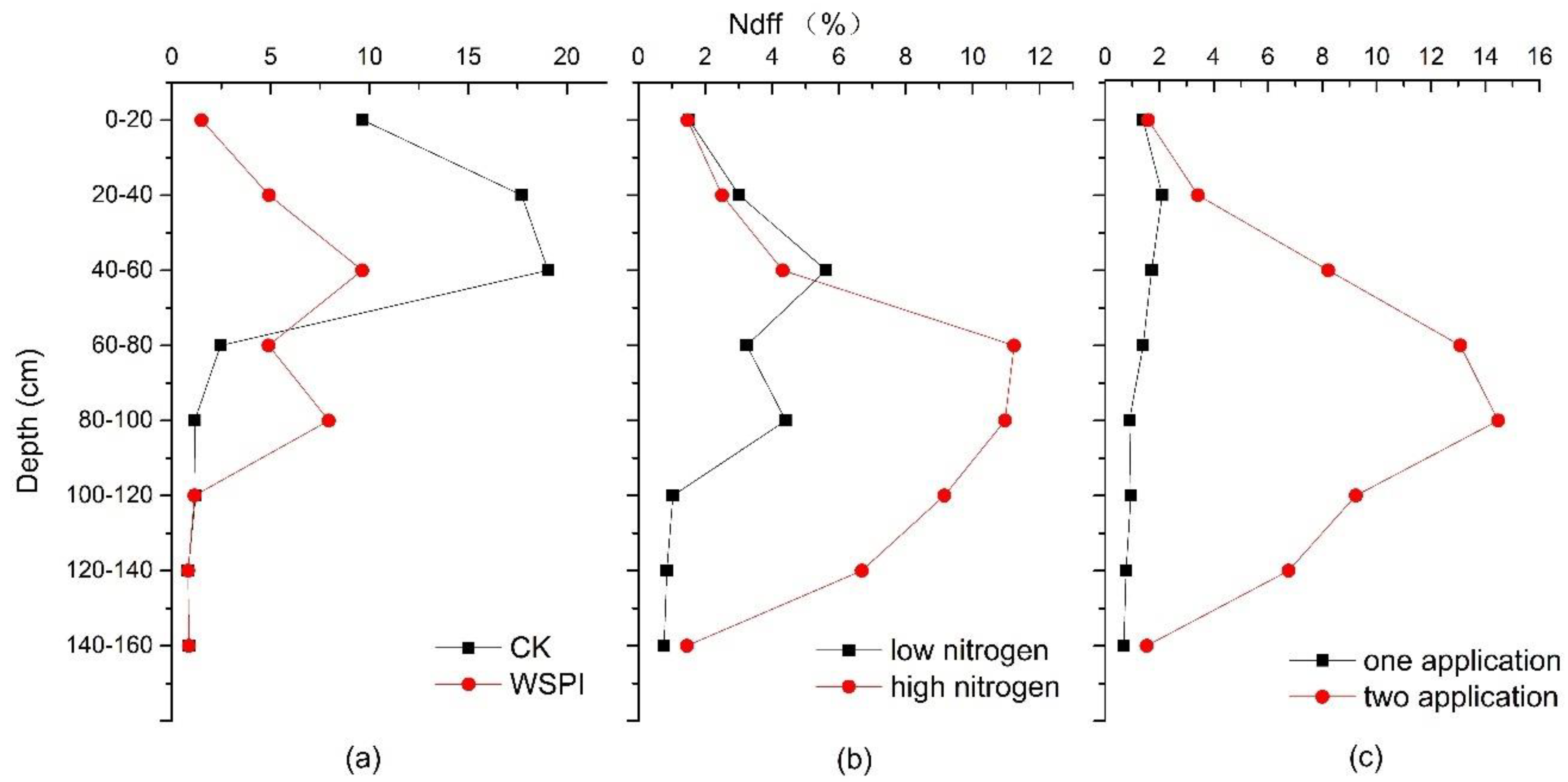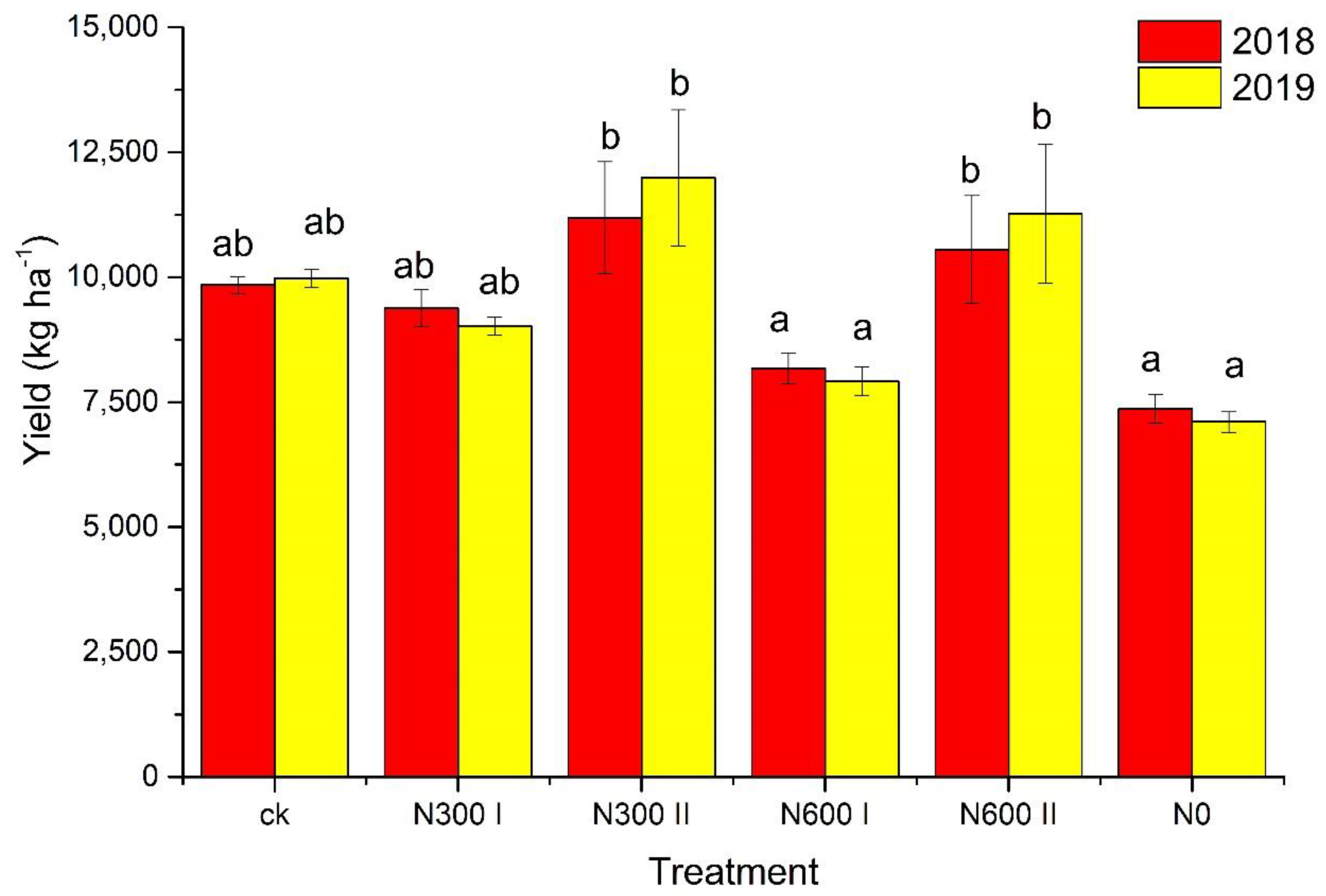Effects of Fertilization Management under WSPI on Soil Nitrogen Distribution and Nitrogen Absorption in Apple Orchard in Loess Plateau
Abstract
1. Introduction
2. Materials and Methods
2.1. Site and Climatic Condition
2.2. Experimental Design
2.3. Sampling and Test Methods
2.4. Calculation and Data Analysis
3. Results
3.1. Fertilizer Nitrogen Residues in Soil
3.2. Change of Fertilizer Nitrogen Residues in Next Year
3.3. The Distribution of Labelled N in Tree Organs
3.4. The Yield of Apple
4. Discussion
5. Conclusions
Author Contributions
Funding
Acknowledgments
Conflicts of Interest
References
- Wang, Y.J.; Liu, L.; Wang, Y.; Tao, H.X.; Fan, J.L.; Zhao, Z.Y.; Guo, Y.P. Effects of soil water stress on fruit yield, quality and their relationship with sugar metabolism in Gala apple. Sci. Hortic. 2019, 258, 108753. [Google Scholar] [CrossRef]
- Wang, D.; Wang, L. Dynamics of evapotranspiration partitioning for apple trees of different ages in a semiarid region of northwest China. Agric. Water Manag. 2017, 191, 1–15. [Google Scholar] [CrossRef]
- Xu, M.D.; Xiao, W.L.; Liu, H.; Song, S.Q. Preparation of pure natural apple powder. Food Sci. Technol. 2014, 39, 92–95, (In Chinese with English abstract). [Google Scholar]
- Song, X.L.; Gao, X.D.; Zhao, X.N.; Wu, P.; Dyck, M. Spatial distribution of soil moisture and fine roots in rain-fed apple orchards employing a Rainwater Collection and Infiltration (RWCI) system on the Loess Plateau of China. Agric. Water Manag. 2017, 184, 170–177. [Google Scholar] [CrossRef]
- Liu, Z.J.; Ma, P.Y.; Zhai, B.N.; Zhou, J.B. Soil moisture decline and residual nitrate accumulation after converting cropland to apple orchard in a semiarid region: Evidence from the Loess Plateau. Catena 2019, 181, 104080. [Google Scholar] [CrossRef]
- Du, S.; Kang, S.; Li, F.; Du, T. Water use efficiency is improved by alternate partial root-zone irrigation of apple in arid northwest china. Agric. Water Manag. 2017, 179, 184–192. [Google Scholar] [CrossRef]
- Shu, L.Z.; Liu, R.; Min, W.; Wang, Y.S.; Yu, H.; Zhu, P.F.; Zhu, J.R. Regulation of soil water threshold on tomato plant growth and fruit quality under alternate partial root-zone drip irrigation. Agric. Water Manag. 2020, 238, 106200. [Google Scholar] [CrossRef]
- Jia, Q.M.; Yang, L.Y.; An, H.Y.; Dong, S.; Chang, S.H.; Zhang, C.; Liu, Y.J.; Hou, F.J. Nitrogen fertilization and planting models regulate maize productivity, nitrate and root distributions in semi-arid regions. Soil Tillage Res. 2020, 200, 104636. [Google Scholar] [CrossRef]
- Lyu, Y.; Porat, R.; Yermiyahu, U.; Heler, Y.; Holland, D.; Dag, A. Effects of nitrogen fertilization on pomegranate fruit, aril and juice quality. J. Sci. Food Agric. 2019, 100, 1678–1686. [Google Scholar] [CrossRef]
- Luo, H.H.; Zhang, Y.L.; Zhang, W.F. Effects of water stress and rewatering on photosynthesis, root activity, and yield of cotton with drip irrigation under mulch. Photosynthetica 2016, 54, 65–73. [Google Scholar] [CrossRef]
- Ippolito, J.A.; Bkorneberg, D.L.; Blecker, S.W.; Massey, M.S. Mechanisms responsible for soil phosphorus availability differences between sprinkler and furrow irrigation. J. Environ. Qual. 2019, 48, 1370–1379. [Google Scholar] [CrossRef] [PubMed]
- Topak, R.; Acar, B.; Uyanoz, R.; Ceyhan, E. Performance of partial root-zone drip irrigation for sugar beet production in a semi-arid area. Agric. Water Manag. 2016, 176, 180–190. [Google Scholar] [CrossRef]
- Sun, X.H.; Ma, J.J.; Guo, X.H. Water storage pit irrigation technique. In Proceedings of the International Conference on Effective Utilization of Agricultural Soil and Water Resources and Protection of Environment on the 4th Annual Academic Conference of Chinese Society of Agricultural Soil and Water Engineering, Nanjing, China, 16 August 2006; Hohai University Press: Nanjing, China, 2006; pp. 211–214. [Google Scholar]
- Zheng, L.J.; Ma, J.J.; Sun, X.H.; Guo, X.H.; Li, Y.Y.; Ren, R.; Cheng, Q.Y. Effective root growth zone of apple tree under water storage pit irrigation using stable isotope methodology. Arch. Agron. Soil Sci. 2019, 65, 1521–1535. [Google Scholar] [CrossRef]
- Ren, R.; Ma, J.J.; Cheng, Q.Y.; Zheng, L.J.; Guo, X.H.; Sun, X.H. An Investigation into the Effects of Temperature Gradient on the Soil Water–Salt Transfer with Evaporation. Water 2017, 9, 456. [Google Scholar] [CrossRef]
- Guo, X.H.; Lei, L.; Sun, X.H.; Ma, J.J.; Zheng, L.J.; Zhang, S.W.; He, Q.Q. Modeling soil water dynamics and root water uptake for apple trees under water storage pit irrigation. Int. J. Agric. Biol. Eng. 2019, 12, 126–134. [Google Scholar] [CrossRef]
- Bangroo, S.A.; Najar, G.R.; Achin, E.; Truong, P.N. Application of predictor variables in spatial quantification of soil organic carbon and total nitrogen using regression kriging in the North Kashmir forest Himalayas. Catena 2020, 193, 104632. [Google Scholar] [CrossRef]
- Wang, X.; Guo, X.; Yu, Y.; Cui, H.; Wang, R.Q.; Guo, W.H. Increased nitrogen supply promoted the growth of non-Nfixing woody legume species but not the growth of N-fixing Robinia pseudoacacia. Sci. Rep. 2018, 8, 17896. [Google Scholar] [CrossRef]
- Sete, P.B.; Comin, J.J.; Ciotta, M.N.; Salume, J.A.; Thewes, F.; Brackmann, A.; Toselli, M.; Nava, G.; Rozane, D.E.; Loss, A.; et al. Nitrogen fertilization affects yield and fruit quality in pear. Sci. Hortic. 2019, 258, 108782. [Google Scholar] [CrossRef]
- Xia, L.L.; Lam, S.K.; Wang, S.W.; Zhou, W.; Chen, D.L.; Yan, X.Y. Optimizing nitrogen fertilization rate to enhance soil carbon storage and decrease nitrogen pollution in paddy ecosystems with simultaneous straw incorporation. Agric. Ecosyst. Environ. 2020, 298, UNSP106968. [Google Scholar] [CrossRef]
- Abalos, D.; Sanchez-Martin, L.; Garcia-Torres, L.; van Groenigen, J.W.; Vallejo, A. Management of irrigation frequency and nitrogen fertilization to mitigate GHG and NO emissions from drip-fertigated crops. Sci. Total Environ. 2014, 490, 880–888. [Google Scholar] [CrossRef]
- Xu, J.T.; Cai, H.J.; Wang, X.Y.; Ma, C.G.; Lu, Y.J.; Lu, Y.B.; Ding, Y.B.; Wang, X.W.; Chen, H.; Wang, Y.F.; et al. Exploring optimal irrigation and nitrogen fertilization in a winter wheat-summer maize rotation system for improving crop yield and reducing water and nitrogen leaching. Agric. Water Manag. 2020, 228, 105904. [Google Scholar] [CrossRef]
- Ierna, A.; Mauromicale, G. Sustainable and profitable nitrogen fertilization management of potato. Agron. Basel 2019, 9, 582. [Google Scholar] [CrossRef]
- Xu, J.T.; Wang, X.Y.; Ding, Y.B.; Mu, Q.; Cai, H.J.; Ma, C.G.; Saddique, Q. Effects of irrigation and nitrogen fertilization management on crop yields and long-term dynamic characteristics of water and nitrogen transport at deep soil depths. Soil Tillage Res. 2020, 198, 104536. [Google Scholar] [CrossRef]
- Qi, Y.; Leng, Y.Y.; Wang, M.; Hu, Y.A.; Bai, Y.E. Design of Decision Support System for Soil Testing and Formula Fertilization based on the Intelligent Agriculture. In Proceedings of the 4th International Conference on Machinery, Materials and Information Technology Applications, Xian, China, 10–11 December 2016; Atlantis Press: Paris, France, 2016; Volume 71, pp. 1402–1407. [Google Scholar]
- Du, X.B.; Zhang, X.Y.; Xi, M.; Kong, L.C. Split application enhances sweetpotato starch production by regulating the conversion of sucrose to starch under reduced nitrogen supply. Plant Physiol. Bioch. 2020, 151, 743–750. [Google Scholar] [CrossRef]
- Jiao, F.; Wu, J.H.; Yu, L.H.; Zhai, R.C. N-15 tracer technique analysis of the absorption and utilisation of nitrogen fertiliser by potatoes. Nutr. Cycl. Agroecosyst. 2013, 95, 345–351. [Google Scholar] [CrossRef]
- Xia, M.J.; Chen, Z.J.; Gao, J.B.; Liu, Z.J.; Li, H.X.; Zhou, J.B. Summer fallow increases loss of residual nitrogen fertilizer in dryland of the Loess Plateau: A 15N-labeled method. Environ. Sci. Pollut. Res. 2018, 25, 34155–34163. [Google Scholar] [CrossRef] [PubMed]
- Campelo, D.H.; Teixeira, A.D.; Moreira, L.C.J.; de Lacerda, C.F. Growth, production and water and nitrogen use efficiency of maize under water depths and nitrogen fertilization. Revista Brasileira Engenharia Agrícola Ambiental 2019, 23, 747–753. [Google Scholar] [CrossRef]
- Hu, X.H.; Qu, F.; Jiang, J.J.; Xu, J.W.; Liu, T. Drip irrigation and fertilization improve yield, uptake of nitrogen, and water-nitrogen use efficiency in cucumbers grown in substrate bags. Plant Soil Environ. 2019, 65, 328–335. [Google Scholar] [CrossRef]
- Bajpai, A.; Kaushal, A. Soil moisture distribution under trickle irrigation: A review. Water Supply 2020, 20, 761–772. [Google Scholar] [CrossRef]
- Chen, W.L.; Jin, M.G.; Ferre, T.P.A.; Liu, Y.F.; Xian, Y.; Shan, T.R.; Ping, X. Spatial distribution of soil moisture, soil salinity, and root density beneath a cotton field under mulched drip irrigation with brackish and fresh water. Field Crop. Res. 2018, 215, 207–221. [Google Scholar] [CrossRef]
- Tang, Y.H.; Cui, Z.Y.; Peng, D.L.; Yin, Y.P.; Li, Y.; Wang, Z.L. Ammonia emission from soil water of wheat field as affected by different nitrogen and irrigation strategies. In Proceedings of the 4th Annual Science and Technology Conference (Tesseract), Gandhinagar, India, 10–12 November 2017; Desalination and Water Treatment: Hopkinton, MA, USA, 2018; Volume 125, pp. 258–264. [Google Scholar] [CrossRef]
- Wu, Y.; Sun, M.D.; Liu, J.; Wang, W.J.; Liu, S.Z. Fertilizer and soil nitrogen utilization of pear tree as affected by the timing of split fertilizer application in rain-fed orchard. Sci. Hortic. 2019, 252, 363–369. [Google Scholar] [CrossRef]
- Bohman, B.J.; Rosen, C.J.; Mulla, D.J. Impact of variable rate nitrogen and reduced irrigation management on nitrate leaching for potato. J. Environ. Qual. 2020, 49, 281–291. [Google Scholar] [CrossRef]
- Morris, M.; Swarts, N.D.; Dietz, C.; Close, D.C. Uptake efficiency and internal allocation of nitrogen in apple trees. In Proceedings of the 8th International Symposium on Mineral Nutrition of Fruit Crops, Bolzano, Italy, 27 June 2017; Acta Horticulturae: Leuven, Belgium, 2018; Volume 1217, pp. 53–59. [Google Scholar] [CrossRef]
- Kastl, E.M.; Schloter-Hai, B.; Buegger, F.; Schloter, M. Impact of fertilization on the abundance of nitrifiers and denitrifiers at the root-soil interface of plants with different uptake strategies for nitrogen. Biol. Fert. Soils 2015, 51, 57–64. [Google Scholar] [CrossRef]
- Shajari, M.A.; Moghaddam, P.R.; Ghorbani, R.; Koocheki, A. The possibility of improving saffron (Crocus sativus L.) flower and corm yield through the irrigation and soil texture managements. Sci. Hortic. 2020, 271, 109485. [Google Scholar] [CrossRef]
- Jing, B.; Shah, F.R.; Xiao, E.S.; Coulter, J.A.; Wu, W. Sprinkler irrigation increases grain yield of sunflower without enhancing the risk of root lodging in a dry semi-humid region. Agric. Water Manag. 2020, 239, UNSP106270. [Google Scholar] [CrossRef]
- Hou, P.F.; Yu, Y.L.; Xue, L.X.; Petropoulos, E.; He, S.Y.; Zhang, Y.S.; Pandey, A.; Xue, L.H.; Yang, L.Z.; Chen, D.L. Effect of long-term fertilization management strategies on methane emissions and rice yield. Sci. Total Environ. 2020, 725, 138261. [Google Scholar] [CrossRef]





| Depth(cm) | Soil Texture | Field Capacity (cm3 cm−3) | Saturated Moisture (cm3 cm−3) | Bulk Density (g cm−3) |
|---|---|---|---|---|
| 0–20 | silt loam | 0.30 | 0.51 | 1.49 |
| 20–40 | silt loam | 0.29 | 0.52 | 1.47 |
| 40–60 | silt loam | 0.28 | 0.52 | 1.44 |
| 60–80 | silt loam | 0.29 | 0.48 | 1.50 |
| 80–120 | silt loam | 0.29 | 0.44 | 1.56 |
| 120–160 | loam | 0.32 | 0.50 | 1.45 |
| Treatment | Irrigation Method | Fertilization Time | Fertilizer Amount (kgN ha−1) |
|---|---|---|---|
| CK | Furrow irrigation | twice | 300 |
| N300Ⅰ | WSPI | once | 300 |
| N300Ⅱ | WSPI | twice | 300 |
| N600Ⅰ | WSPI | once | 600 |
| N600Ⅱ | WSPI | twice | 600 |
| N0 | WSPI | none | 0 |
| Treatment | Shallow (0–40 cm) | Middle (40–100 cm) | Deep (100–160) | Total |
|---|---|---|---|---|
| CK | 13.69 ± 5.69a | 7.57 ± 9.92ab | 0.97 ± 0.21a | 6.61 ± 2.77ab |
| N300Ⅰ | 1.32 ± 0.31b | 1.37 ± 0.40a | 0.83 ± 0.12a | 1.14 ± 0.13a |
| N300Ⅱ | 3.22 ± 2.40ab | 7.47 ± 2.38ab | 0.93 ± 0.15a | 3.96 ± 1.22a |
| N600Ⅰ | 2.18 ± 1.30b | 1.30 ± 0.46a | 0.80 ± 0.17a | 1.33 ± 0.28a |
| N600Ⅱ | 1.79 ± 0.17b | 16.37 ± 8.29b | 10.73 ± 7.74b | 10.61 ± 3.02b |
| Treatment | 2018 | 2019 | ||||
|---|---|---|---|---|---|---|
| Fruit | Leaf | Root | Fruit | Leaf | Root | |
| CK | 3.36 ± 0.73a | 2.87 ± 0.59a | 5.40 ± 0.53a | 9.62 ± 0.45a | 3.11 ± 0.61a | 7.46 ± 0.36a |
| N300Ⅰ | 6.06 ± 0.65b | 9.83 ± 0.63bc | 27.20 ± 0.52b | 11.55 ± 0.66a | 9.96 ± 0.99b | 17.21 ± 0.15b |
| N300Ⅱ | 11.83 ± 0.71c | 8.33 ± 0.98b | 22.56 ± 0.33c | 32.13 ± 0.75b | 6.77 ± 0.85c | 13.80 ± 0.23c |
| N600Ⅰ | 5.98 ± 0.45b | 3.74 ± 0.86a | 24.39 ± 0.22d | 10.57 ± 0.83a | 2.50 ± 0.44a | 23.29 ± 0.51d |
| N600Ⅱ | 11.58 ± 0.79c | 17.71 ± 1.14d | 17.07 ± 0.45e | 21.33 ± 0.64c | 11.85 ± 0.92c | 22.12 ± 0.21e |
© 2020 by the authors. Licensee MDPI, Basel, Switzerland. This article is an open access article distributed under the terms and conditions of the Creative Commons Attribution (CC BY) license (http://creativecommons.org/licenses/by/4.0/).
Share and Cite
Cheng, Q.; Ma, J.; Ren, R.; Zheng, L.; Guo, X.; Sun, X. Effects of Fertilization Management under WSPI on Soil Nitrogen Distribution and Nitrogen Absorption in Apple Orchard in Loess Plateau. Agronomy 2020, 10, 1386. https://doi.org/10.3390/agronomy10091386
Cheng Q, Ma J, Ren R, Zheng L, Guo X, Sun X. Effects of Fertilization Management under WSPI on Soil Nitrogen Distribution and Nitrogen Absorption in Apple Orchard in Loess Plateau. Agronomy. 2020; 10(9):1386. https://doi.org/10.3390/agronomy10091386
Chicago/Turabian StyleCheng, Qiyun, Juanjuan Ma, Rong Ren, Lijian Zheng, Xianghong Guo, and Xihuan Sun. 2020. "Effects of Fertilization Management under WSPI on Soil Nitrogen Distribution and Nitrogen Absorption in Apple Orchard in Loess Plateau" Agronomy 10, no. 9: 1386. https://doi.org/10.3390/agronomy10091386
APA StyleCheng, Q., Ma, J., Ren, R., Zheng, L., Guo, X., & Sun, X. (2020). Effects of Fertilization Management under WSPI on Soil Nitrogen Distribution and Nitrogen Absorption in Apple Orchard in Loess Plateau. Agronomy, 10(9), 1386. https://doi.org/10.3390/agronomy10091386




